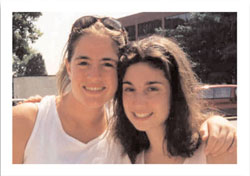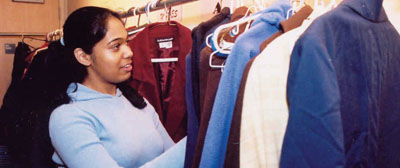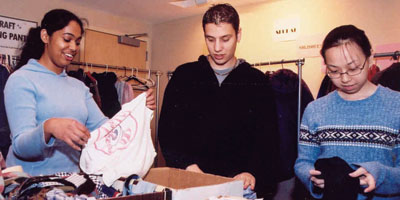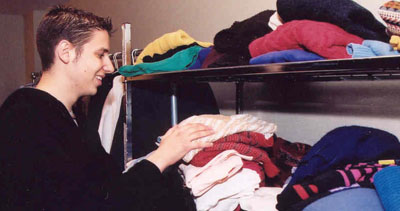|
|
 |
 |
 |
 |
|
FEATURESStudents Give, Get Much in ReturnIn addition to benefiting the needy, the Kraft Clothing Pantry has channeled student philanthropy and taught its volunteers valuable lessons.By Sarah Lorge Butler ’95One Friday morning last winter, while many undergraduates were still snuggled comfortably in their sheets, Amanda Resnikoff ’06 had already worked herself into a lather. It was 9 a.m. and she was setting up the Kraft Clothing Pantry, arranging heavy tables, dragging racks of clothing filled with winter coats and heavy sweaters into position and lugging boxes of shoes onto an elevator. With one volunteer in bed with the flu and another running late, Resnikoff hustled to get the set-up just so before the pantry opened at 10 a.m. sharp. She had reason to hurry: The previous week, 23 clients seeking clothing for themselves and their families were waiting outside the pantry’s doors.
The Kraft Clothing Pantry is a student-run organization that provides free clothing to homeless and low-income people in Morningside Heights and elsewhere in the city. Resnikoff is one of the coordinators of the group, which is part of Tzedek Hillel, the social justice arm of the Kraft Family Center for Jewish Student Life. The pantry comes to life each Friday during the academic year from 10 a.m. to 3 p.m. in the lobby space of Kraft’s Rennert Hall. Inside, a smiling cadre of volunteers greets the clients, takes their information — name, address, number of family members they’re shopping for and the referring agency — and enters it into a database. Then, clients are free to browse. The basic operating procedures are simple: Clients spend as much time as they want browsing through the clothing and can take within limits: two pairs of pants, two sweaters, one pair of shoes per family member. As clients check out, the items are entered into the computer, and the client can return in two weeks. But those limits often serve more as guidelines, Resnikoff explains, after a woman departs with three sweaters. “She hasn’t been here in a year. And sweaters? We have plenty of sweaters.” A desire to channel student magnanimity and take advantage of valuable real estate gave rise to the clothing pantry. In Fall 1999, before Hillel moved from Earl Hall into the new Kraft Center, Rabbi Jennie Rosenn ’91 gathered a group of student leaders to consider how the new building could be a resource to the neighborhood. “The new space was beautiful and huge, and space in Manhattan is a rare commodity,” says Alison Hirsh ’02, who cofounded the pantry with Marnie Glassman ’02. “We wanted to make sure we put it to better use than simply [for ourselves].” The students began a needs assessment to see what services the neighborhood lacked and to determine what students could feasibly provide. Glassman, Hirsh and several others began interviewing local clergy, social service providers, community activists, politicians and police. They talked to more than 50 people to develop a sense of what Morningside Heights most needed. Two ideas — a clothing pantry and a daycare center — surfaced repeatedly. A daycare center, which would require licensing and insurance, was quickly deemed impractical for students to run. Thus, the clothing pantry was born. The students set about seeing how other clothing donation centers in the city operated. They surveyed at least 12 organizations, asking them how they obtain clothing, how it is distributed, what their rules are and whether other services are offered. “We got an abundance of ideas,” says Glassman, who now attends Harvard Business School. “Then we had to sort through and decide which ones made the most sense for us.” That’s where Glassman and Hirsh took over, and the clothing pantry developed according to their vision. Suitemates during freshman year and involved in Community Impact, the duo shared a passion for service. They spent long hours during their sophomore year drawing maps of the space, meeting with Rosenn and talking about procedures and potential pitfalls. “Marnie and Ali were very sophisticated in their thinking about things such as referrals and limits and how you find that balance between ensuring clients’ dignity and ensuring that a few don’t take advantage of the program at the expense of others,” recalls Rosenn, who until last winter was associate Jewish chaplain and director of Tzedek Hillel. Their foresight proved remarkably accurate; the plan the pair developed remains largely intact today. The guiding principle behind the pantry is kavod, a Hebrew word that means honor or dignity. Where other clothing centers in the city operate like a closet — a client requests pants and a staffer gets a pair of pants — Glassman and Hirsh wanted the Kraft pantry to resemble a retail experience. “In everything we did, we wanted to make sure people were treated with respect,” says Hirsh, who works in Brooklyn for New York State Assemblyman Vito Lopez. “We wanted people to have some control over their choices.” By the end of Spring 2000, Glassman and Hirsh had begun collecting clothing. When members of the Class of ’00 moved out of their dorms after graduation, the pantry yielded a wealth of donations, which were sorted during the summer. In the fall, Glassman and Hirsh ran a clothing sort as a freshman orientation event and held pizza nights to entice students to help organize clothes and recruit volunteers. By February 2001, having publicized the service at nearby churches, synagogues and social service agencies, they were ready to open. “Our first concern,” Glassman says, “was whether anyone was going to show up.” The first day, 10 people came. Four Fridays later, 50 clients passed through the doors. Though the pantry mostly had been publicized on the Upper West Side, people soon started coming from Brooklyn and the Bronx. Now, in its fourth year, the pantry database holds approximately 500 client names.
It hasn’t been entirely smooth sailing, and the pantry has evolved to handle unanticipated developments. A security guard was hired to watch over the pantry during operating hours. Common questions and answers needed to be translated into Spanish. There’s never enough large-size clothing and men’s clothing is especially hard to come by, as is professional apparel, baby clothes, winter coats, gloves and underwear. Mounds of unsorted clothing sit in storage upstairs, because donations are plentiful but time for sorting is not. Each week, it’s a race to get the pantry dismantled and the parts put away upstairs before the automated Shabbat elevator starts stopping on every floor. But such challenges only inspire student ingenuity. A lot of funky, older-style clothing didn’t fit clients’ needs, so volunteers took items that were being passed over week after week and held a “vintage” clothing sale on College Walk. With the $200 they earned, the pantry bought staples, like underwear and socks. Students began to question why the pantry’s patrons were in need of clothing donations. In the second semester, Glassman and Hirsh invited representatives from Community Impact’s Advocacy Coalition to set up a table at the pantry. Advocacy Coalition provides referrals to other services a client might need — soup kitchens, substance abuse programs, shelters, even pro bono legal services or medical help. The student volunteers, says Amy Ravis, director of Tzedek Hillel programming, “look at things systemically. They know that people’s need for clothing is a symptom of something larger, that people are in need of other services, and students are thinking about them holistically. I’m constantly impressed with their sensitivity and passion.” Glassman and Hirsh also had to start thinking about how the pantry would continue after they graduated. For the last two years of their undergraduate days, they were up every Friday before 8 a.m. to work at the pantry. Not every volunteer shared their level of commitment, but the pair uncovered three dedicated students to take over as coordinators and put them through a rigorous training, showering them with logistical information and putting them through role-plays. “How do you deal with a belligerent client who wants to take a garbage bag full of clothes?” Hirsh asks. “How do you be an enforcer? It’s not easy.” The training paid off, and under the second generation’s coordinators, Tara Coleman ’05 Barnard, Jessica Leber ’04 and Joyce Liu ’05, the pantry flourished and improved. Those three installed new coordinators, including Resnikoff and Christina Persaud ’06, at midyear, so there would be a semester overlap if new questions arose, and they developed a comprehensive training manual of procedures for set-up, clothing limits and staffing. The results have been far-reaching and friendships have been forged. One man who frequented the pantry, showing off pictures of his infant daughter, stopped coming. He turned up a few months later to explain that a new job was keeping him away. “We’ve had a few clients fold clothing and organize, becoming volunteers for a little while,” Leber says. “That was a nice thing. There’s definitely a rapport — they chat about their lives, we know their names.” For the students, the experience has been eye-opening. “Every day was a lesson in how fortunate I’ve been,” Glassman recalls. Hirsh echoes her friend’s view, and notes that it also showed her something more. “It gave me perspective on how a lot of people in my college world lived,” she says. “You should see some of the clothing that was donated: an Armani suit with the tags on it, Banana Republic, Abercrombie.” While indigent New York families left the pantry with clothes for a season, the students gained experience in management, community organizing, coordinating volunteers, fund raising and working with the public and the Columbia administration. “I don’t know how many other people can say they ran a small social service organization from the top down in college,” Leber notes. The volunteers are grateful to see a child dressed warmly, a parent treated with dignity, a need filled. “When I was interviewed for the job I have now,” Hirsh says, “my boss asked me to name the one thing I’ve done that I’m most proud of, and the clothing pantry is it.” Sarah Lorge Butler ’95 is an editorial projects writer at Sports Illustrated.
|
|
|||||||||||||||||||||||||||||||||||||||||||||||||||||||||||||||||



